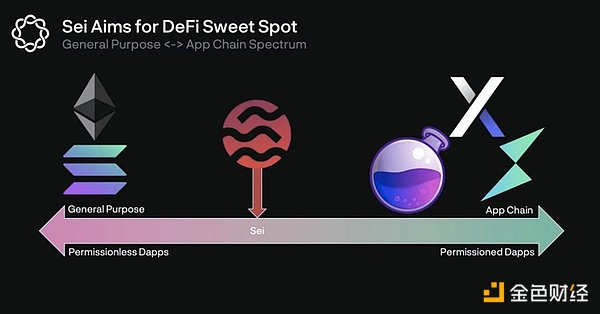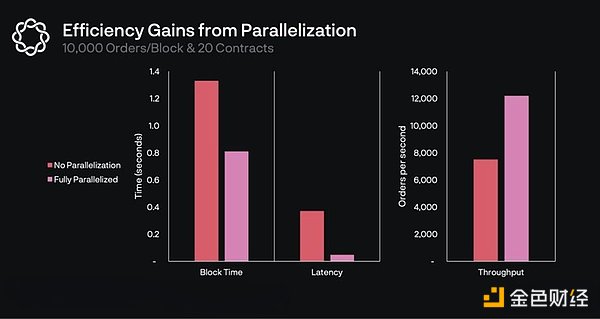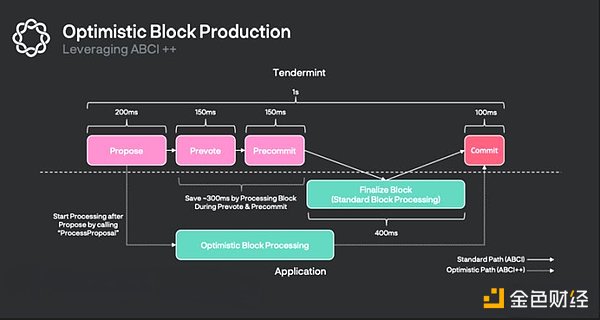The SEC’s lawsuit against Binance has been the biggest event in the crypto industry in the past month. As a result of this event, the prices of the vast majority of cryptocurrencies have plummeted in the past few weeks, and the crypto market, which had just entered a small spring, has once again fallen into the shadow of a bear market. This event has also caused crypto users to begin losing trust in centralized exchanges (CEX), further strengthening the need to develop decentralized exchanges (DEX). Sei Network, a Layer1 public chain built using Cosmos SDK, aims to become the preferred chain for DEX in DeFi, NFT and GameFi. Sei’s built-in order book infrastructure, extremely fast execution speed, deep liquidity, and fully decentralized matching service provide DEX with a more secure, transparent, efficient, and reliable network, and also bring new opportunities for innovation and development to the crypto market.
Sei is built for trading and aims to be the fastest layer1 public chain
Traditional Layer1 public chains can be roughly divided into two categories: general-purpose chains such as Ethereum, Solana, etc., and application-specific chains such as dYdX, Osmosis, etc. These public chains have their unique advantages and characteristics in technology implementation but have certain limitations in transaction scalability.
Sei, as a new Layer1 public chain, is different from other public chains, and it does not choose sides between general-purpose chains and application-specific chains. Instead, Sei has found a middle ground between the two and become a public chain built specifically for trading. Compared with general-purpose chains, Sei has optimized every aspect of its technology stack to provide the best trading infrastructure. Compared with application-specific chains, Sei is a relatively general-purpose public chain that can support various trading applications rather than targeting a specific application. This makes Sei a more flexible and customizable trading infrastructure that can meet the needs of different types of trading applications.

- Quick look at opBNB, BNB Chain’s scaling solution, which can support over 4000 transfer transactions per second.
- What problems does Uniswap v4 solve for DEX? Is it possible to disrupt CEX?
- Inventory of the Polygon zkEVM ecosystem
As a public chain focused on trading, Sei aims to solve the scalability problems faced by current on-chain exchanges and become the fastest Layer1 public chain. To achieve this, Sei has implemented several important improvements to its underlying network architecture, including the Twin Turbo consensus mechanism that achieves industry-leading performance levels. Sei’s success in technology largely comes from the Twin Turbo consensus, which can help Sei achieve a lower limit of 300 milliseconds for final confirmation time, 10 times faster than Solana. In addition, Sei has also implemented a composable architecture order matching module, which means that dApps on Sei have synchronous composability. Through Sei’s numerous bridging partners, the IBC, EVM, and SVM ecosystems will all have asynchronous composability, enabling seamless connections and interoperability between different blockchain ecosystems, and developers can more flexibly choose the technology stack that suits their needs.
Sei has also increased throughput by 5-10x through market-based parallelization technology, and supports batch processing of orders, simplifying the process of updating multiple orders across different exchanges. These are innovative features that Sei has implemented in optimizing trading application performance. In addition, Sei’s liquidity center and underlying technology are also very favorable for various dApp operations. Sei’s liquidity management system can help DeFi, GameFi, and NFT applications provide users with deeper liquidity systems and cost-effective transaction processes while taking advantage of the agility and efficiency of the Sei blockchain.
Trading is the most basic application scenario and use case of blockchain technology, and it is also an important force driving the development of blockchain and Web3. Sei provides a striking product for developers who want to build applications on the general Layer 1 by building a dedicated trading public chain. Sei’s appearance fills the gap of trading-exclusive public chains, bringing new opportunities and challenges for the development of blockchain technology and Web3, and providing more possibilities for the circulation and transaction of digital assets.
Sei’s technological advantages are disrupting the traditional DEX network environment
With the rapid development of Web3, exchanges as asset trading hubs have become increasingly important. Currently, exchanges are mainly divided into centralized exchanges and decentralized exchanges. In the past, centralized exchanges have always been dominant. However, as the leading centralized exchange Binance has been sued by regulatory authorities, higher regulatory pressure on centralized exchanges will push the market towards decentralized exchanges. This requires DEX to expand and adapt to the huge wave of adoption.
Given that DEX has unique requirements for speed, throughput, reliability, and front-running trading, specialized infrastructure needs to be built to address these issues. Sei was born for this purpose. It provides a solution to the scalability problem of DEX and enables exchange applications to effectively scale while maintaining decentralization and capital efficiency. Sei’s technological advantages mainly include the following:
Order Matching Engine
Sei is a Layer 1 public chain based on the Cosmos ecosystem. Like Ethereum, Sei also allows users to transfer assets and deploy smart contracts. However, Sei’s feature is that it also creates an order submission and matching engine at the chain level. This order matching engine is one of Sei’s core features because it allows anyone who wants to build an exchange to easily use this engine to create an order book-based exchange. This means that builders can skip the step of building an order book from scratch, making it more efficient in terms of technology and cost.
Additionally, Sei’s order matching engine offers a limit order design space similar to conventional centralized exchanges such as Binance and Coinbase. It creates a set of orders at different prices and allows for the update of asset values according to executed orders. The benefit of using an order book exchange is that it can provide higher liquidity and better price discovery mechanisms. Although technically challenging to launch and provide liquidity for an order book-based exchange compared to an AMM DEX, Sei aims to provide a cost-effective system for developers and users building decentralized applications on the network. This allows them to build order book-based exchanges more efficiently without compromising security and reliability.
Parallel Order Execution
Sei’s parallel order execution is a significant improvement. It can process orders in the same market in sequence while simultaneously processing orders from different markets. This approach significantly increases Sei’s throughput while ensuring deterministic behavior among validators. In traditional blockchains, order processing occurs sequentially, meaning that each order must be processed in the exact order received, regardless of the assets or markets it interacts with. Sei’s approach is different, allowing orders from independent markets to be processed simultaneously, resulting in faster block times, lower latency, and higher throughput for Sei at all load levels. This marginal improvement is particularly significant at high loads.

According to data from Sei’s internal testing, with 10,000 orders per block and 20 different contracts (markets), parallel processing reduced block times from 1.33 seconds to 0.81 seconds, latency from 371 milliseconds to 48 milliseconds, and increased throughput from 7,500 orders per second to 12,200 orders per second. As the load increases, the marginal optimization becomes more significant.
Twin-Turbo Consensus Mechanism
Sei’s Twin-Turbo consensus mechanism optimizes and upgrades the ABCI of Cosmos by making each step of consensus programmable. The consensus mechanism consists of two parts: intelligent block propagation and optimistic block processing.
Intelligent block propagation aims to increase block processing speed and efficiency. On the Sei Network, block proposers can send compressed block proposals containing only transaction hashes instead of detailed block contents. During the block broadcast phase, if validators have all the transactions in the proposal in their local memory pool, they will rebuild the entire block from their memory pool without waiting for all block parts to arrive. This process significantly reduces the total time validators wait to receive a block. If a validator does not have transactions in its memory pool, it can simply revert to waiting for the uncompressed detailed proposal. According to Sei’s tests, in over 99.9% of cases, each validator already has the transactions in its local memory pool due to the gossip mechanism of the network. Therefore, this intelligent block propagation greatly accelerates Sei’s throughput while still ensuring the validity of transactions.

Optimistic rollup is a blockchain validation method that enables faster and more efficient validation. Unlike traditional non-optimistic blockchains, optimistic rollup skips the pre-voting and pre-submit steps, allowing validators to call the block-ending function directly, thus speeding up block validation and voting. On Sei Network, validators can also optimistically process the first block proposal they receive at any height by initiating parallel processing and writing state candidates to cache. This greatly reduces the waiting time caused by delays in block production, thus improving Sei’s throughput.
Through the Twin-Turbo consensus mechanism, Sei reduces block confirmation time from 6 seconds on the Cosmos chain to 500 milliseconds, achieving the fastest final block confirmation time in the entire network and a throughput of 20,000 transactions per second. This efficient consensus mechanism also makes Sei a high-performance, scalable, and programmable blockchain system that provides faster and more efficient services for DEXs.
In addition to the three main improvements mentioned above, Sei has added other features at the base layer, including:
1. Single-block order execution: In Sei, it is allowed to place and execute orders in a single block, while in Serum it requires multiple blocks to complete.
2. Order bundling: Market makers can update prices for multiple markets in a single trade, improving efficiency.
3. Frequent batch auctions: Market orders can be aggregated at the end of the block for settlement at a single price. This method is designed to attempt and minimize front-running.
4. Native price oracle: A native price oracle is integrated into Sei’s base layer to ensure reliable price information from on-chain markets.
The introduction of these features can further improve Sei’s efficiency and scalability, making it a more comprehensive blockchain network that provides better services for DEXs.
Sei Network Ecosystem Development
Ecosystem layout has always been a focus of Sei’s development, especially after entering 2023. In January and April, Sei received two ecosystem investment funds successively. Among them, MEXC’s $20 million crypto ecosystem fund and Foresight Ventures and Bitget’s $50 million crypto ecosystem fund, plus the $50 million investment from Multicoin Capital, DelphiDigital, Hypersphere, and many other investment institutions and market makers in September last year. As of now, the total size of Sei’s ecosystem fund has soared to $120 million.
These ecological investment funds provide Sei with more resources and support, helping Sei further expand its influence and market share in the blockchain field. The participation of numerous institutions also reflects the widespread optimism about the prospects of Sei’s exclusive trading public chain.
Although Sei’s mainnet has not yet been launched, its ecosystem has already attracted many well-known projects. As of now, more than 150 teams have gathered on Sei Network to develop projects, covering multiple areas such as infrastructure, DEX, MEV, cross-chain, NFT, and mortgage lending. According to the latest financing report, there are already 120 cooperative projects in the Sei Network ecosystem. Currently, about 70 cooperative projects are disclosed on the official website, with a focus on decentralized exchanges, infrastructure, wallets, and cross-chain bridges. The addition of these cooperative projects injects new vitality and momentum into the construction and development of the Sei ecosystem, and also provides users with more choices and services.

Key projects of Sei Network
Decentralized exchanges (DEX):
-
Sushiswap: An AMM-based DEX that launched a decentralized perpetual futures exchange on Sei Network in January 2023.
-
Satori: A chain-based evolutionary product protocol established on Polkadot, which provides an evolutionary product protocol on Sei Network.
Infrastructure:
-
White Whale: A cross-chain liquidity protocol that provides tools for efficient markets through arbitrage, flash loans, and cross-chain liquidity pools, and will conduct airdrop activities on Sei Network to reward validators and token holders.
-
Kado: Supports basic settings and allows Sei users to use their non-custodial wallet transfer rules and digital assets.
Wallet:
-
Keplr: A wallet for cross-blockchain ecosystems that supports Sei Network tokens and applications.
-
Cosmoscan: A verification node operator and wallet provider that provides a block explorer for Sei Network.
Cross-chain bridge:
-
Gravity Bridge: A cross-chain bridge that supports the transfer of assets and messages between Cosmos and Ethereum, providing open access to DeFi projects in the Sei Network ecosystem.
-
Axelar: Can provide various services, including multi-chain flow fund pools, to bring cross-chain liquidity into Cosmos, which will make it easier for Sei to obtain liquidity outside of Cosmos.
Summary
Sei Network is known as the decentralized NASDAQ, aiming to build a blockchain that focuses on DeFi infrastructure. To achieve this goal, Sei has introduced various technological applications to improve the trading experience, including modular order matching, Twin-Turbo consensus, and parallel order execution and local price oracles, among other basic layer functions. By coordinating these protocols, systems, and algorithms, Sei provides the best infrastructure for trading applications and exchanges. In the fast-paced world of trading and innovative technology, speed, scalability, and affordability are essential factors. As a high-performance, general-purpose Layer1 public chain, Sei has become the preferred solution for traders, developers, and gaming communities.
Like what you're reading? Subscribe to our top stories.
We will continue to update Gambling Chain; if you have any questions or suggestions, please contact us!